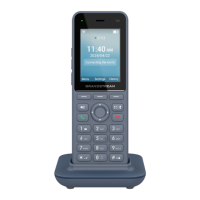2. Log in to the Web GUI as an administrator on the PC.
3. Go to Web GUI🡪Maintenance🡪Upgrade and Provisioning 🡪 Firmware.
4. Click the “Start” button under “Upgrade Firmware”, and a window will be prompted to select the firmware file to upload.
5. Select the firmware file from your PC. Then uploading progress will show on the window.
6. When uploading is done, users can see the upgrading process starts on the device LCD.
7. The phone will reboot again with the new firmware version upgraded.
No Local Firmware Servers
Service providers should maintain their firmware upgrade servers. For users who do not have a TFTP/HTTP/HTTPS/FTP/FTPS
server, some free Windows version TFTP servers are available for download from:
https://www.solarwinds.com/free-tools/free-tftp-server and https://www.tftpd64.com/.
Please check our website athttps://www.grandstream.com/support/firmwarefor the latest firmware.
Instructions for local firmware upgrade via TFTP:
1. Unzip the firmware files and put all of them in the root directory of the TFTP server.
2. Connect the PC running the TFTP server and the device to the same LAN segment.
3. Launch the TFTP server and go to the File menu🡪Configure🡪Security to change the TFTP server’s default setting from
“Receive Only” to “Transmit Only” for the firmware upgrade.
4. Start the TFTP server and configure the TFTP server in the phone’s web configuration interface.
5. Configure the Firmware Server Path on your device to the IP address of the PC.
6. Update the changes and reboot the device.
End users can also choose to download a free HTTP server from https://httpd.apache.org/ or use a Microsoft IIS web server.
Provisioning and Configuration File Download
Grandstream SIP Devices can be configured via the Web Interface as well as via a Configuration File (binary or XML) through
TFTP or HTTP/HTTPS FTP/FTPS. The “Config Server Path” is the TFTP, HTTP or HTTPS, FTP, or FTPS server path for the
configuration file. It needs to be set to a valid URL, either in FQDN or IP address format. The “Config Server Path” can be the
same or different from the “Firmware Server Path”.
A configuration parameter is associated with each particular field in the web configuration page. A parameter consists of a
Capital letter P and 1 to 5 (could be extended to more in the future) digit numeric numbers. i.e., P2 is associated with the
“Admin Password” in the Web GUI🡪Maintenance🡪 Web Access page. For a detailed parameter list, please refer to the
corresponding firmware release configuration template in the following link:
https://www.grandstream.com/support/tools
When the handset boots up, it will issue a TFTP, HTTP(S), or FTP(S) request to download a configuration XML file named
“cfgxxxxxxxxxxxx” followed by “cfgxxxxxxxxxxxx.xml”, where “xxxxxxxxxxxx” is the MAC address of the phone, i.e.,
“cfg000b820102ab” and “cfg000b820102ab.xml”. If downloading “cfgxxxxxxxxxxxx.xml” file is not successful, the provision
program will download a generic cfg.xml file. The configuration file name should be in lowercase letters.
For more details on XML provisioning, please refer to the following document:
https://documentation.grandstream.com/knowledge-base/sip-device-provisioning-guide/

